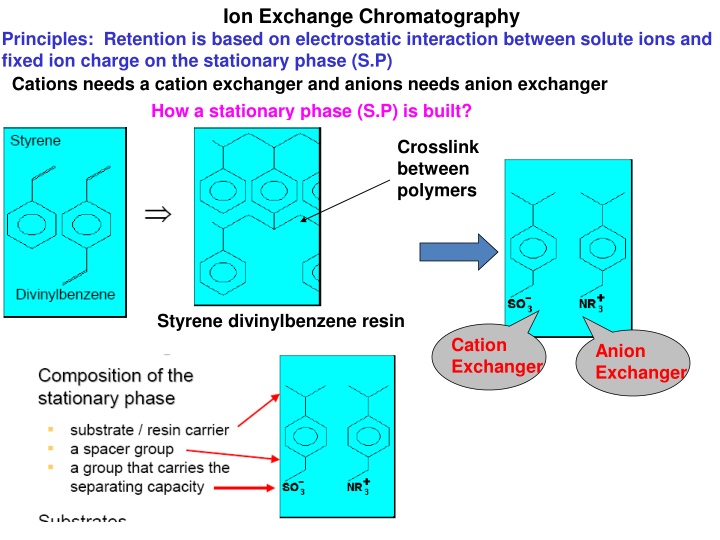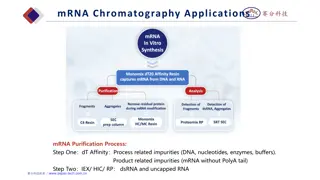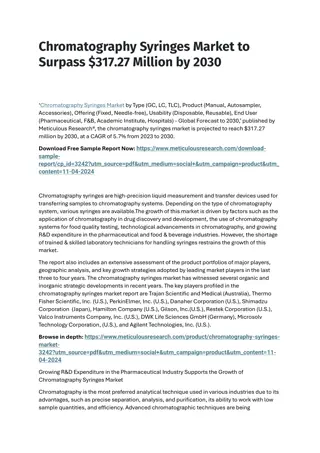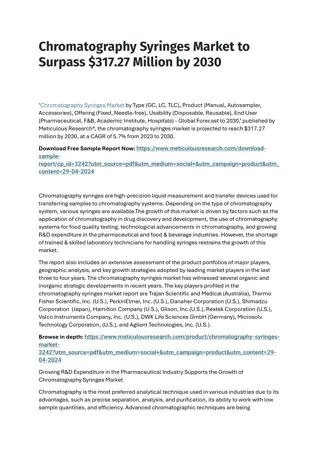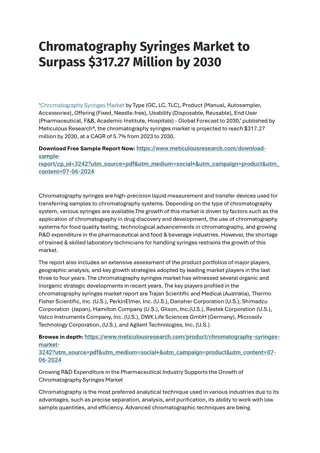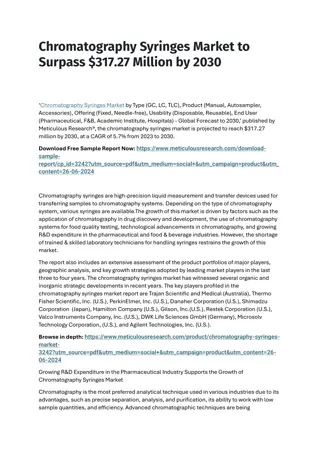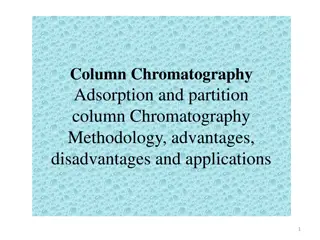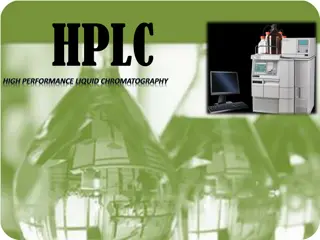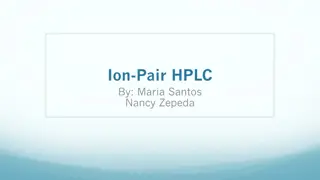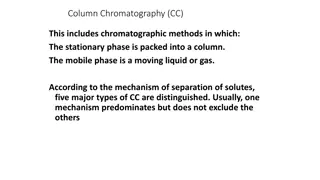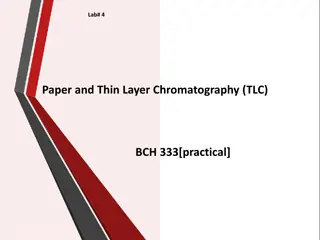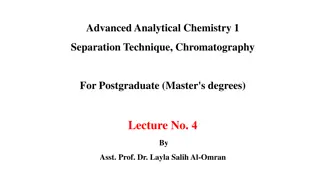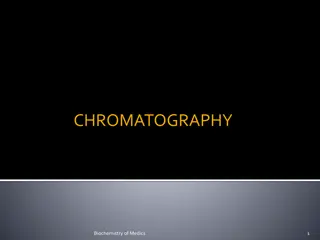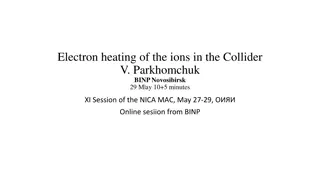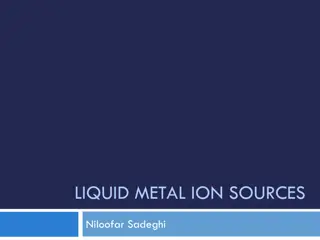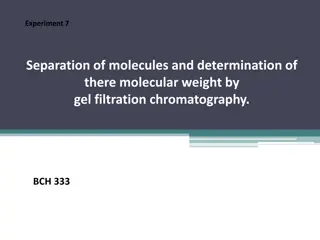Ion Exchange Chromatography Principles and Mechanism
Retention in Ion Exchange Chromatography is based on electrostatic interactions between solute ions and fixed ion charges on the stationary phase. This technique utilizes cation and anion exchangers to separate compounds based on their ionic properties. The stationary phase is built by crosslinking polymers, such as styrene divinylbenzene resin, to create strong cation and anion exchange groups. The retention of ionic compounds is influenced by factors like pH of the mobile phase and the characteristics of the weakly acidic cation exchanger. The mechanism of retention involves displacing counterions with sample ions on the stationary phase. Synthesis of polymeric-based ion exchange columns involves copolymerization of styrene with divinylbenzene and subsequent sulfonation or amination of the copolymer.
Download Presentation

Please find below an Image/Link to download the presentation.
The content on the website is provided AS IS for your information and personal use only. It may not be sold, licensed, or shared on other websites without obtaining consent from the author.If you encounter any issues during the download, it is possible that the publisher has removed the file from their server.
You are allowed to download the files provided on this website for personal or commercial use, subject to the condition that they are used lawfully. All files are the property of their respective owners.
The content on the website is provided AS IS for your information and personal use only. It may not be sold, licensed, or shared on other websites without obtaining consent from the author.
E N D
Presentation Transcript
Ion Exchange Chromatography Principles: Retention is based on electrostatic interaction between solute ions and fixed ion charge on the stationary phase (S.P) Cations needs a cation exchanger and anions needs anion exchanger How a stationary phase (S.P) is built? Crosslink between polymers Styrene divinylbenzene resin Cation Exchanger Anion Exchanger
(aka. backbone) Polymeric Silica-based Ion-Exchange Groups (A group that carries a separation capacity) Strong Cation Exchanger Weak Cation Exchanger At low pH CM loses cation exchange capacity due to protonated S.P Strong Anion Exchanger Weak Anion Exchanger At high pH DEAE loses anion exchange capacity due to deprotonated S.P
What mobile phase characteristics will affect the retention of ionic compounds (e.g., cations) if weakly acidic cation exchanger is used? *pH of the M.P. The M.P affects retention of cations. For example, at low pH the ionogenic groups of the resin is protonated and cation exchanger loses its ion-exchange capacity -------- tR of cations decreases (case a) pH>8 4<pH<8 pH <4 COO- COOH COO- COO- COOH COOH COO- COOH COO- COO- COOH COOH a) Undissociated weak cation exchanger b) Partially dissociated weak cation exchanger c) Dissociated weak cation exchanger
Mechanism of Retention in Ion-Exchange Chromatography (IEC) Taken from Weston Some sample ions have already being displaced by M.P counterions All M.P counterions except one has been displaced frome the IE sites 1. The column is equilibrated with the M.P and the counterions have occupied ion-exchange sites on the S.P. The sample ions are injected and are about to enter the first segment of S.P 2. As the sample cations enters the column they start displacing the M.P counterions from the ion- exchange sites on the S.P (process called adsorption of solute ions on the S.P). 3. Because this is a flowing system(M.P is continously being flushed into the column). Therefore,the M.P counterions will start displacing the sample ions from the IE sites. 4. After all the sample ions are eluted off the column the S.P is regenerated (ie., flushed with M.P counterions) to clean off extra sample ions that have retained on the S.P
Synthesis of polymeric-based ion-exchange columns I. Copolymerization of styrene with divinylbenzene II. Sulfonation or amination of copolymer (PSDVB)
Type of Ion-Exchange packing material Strongly acidic cation-exchange resin prepared from sulfonation of PSDVB
Strongly basic anion exchanger is prepared from amination of PSDVB
Polymeric resins are made in 3-D networks by cross-linking hydrocarbon chains. The resulting resin is insoluble, inert and relatively rigid. Ionic functional groups are attached to this framework. Crosslinking is a measure of polymer strength. --Heavily crosslink resin have more IE sites-----tR increases --Liqhtly crosslink resin have less IE sites ---- tR decreases --Resin crosslinking varies from 2 10%. Resin <2% crosslink are soft gels Lightly crosslinked Equilibrium Between S.P and M.P, which Increase N but also tR resins sells with organic solvents (if lightly crosslinked) Heavily crosslinked- More rigid and less Porous. Slow equilibration of solutes. Higher IE capacity, tR increases, N increases) Resins do not swell with organic solvents due to greater mechanical strength rapid
Ion-Exchange Equilibria: Due to the competition between M.P counterions and sample ions an equilibrium is established between the counterions (C+) and the sample ions (S+) F-C+ + S+ F-S++ C+ (S.P) (M.P) (S.P) (M.P) S+ = sample ions C+ = counter ions of the M.P Ions of same charge are reversibly exchange between the two phases
Ion-Exchange Selectivity Selectivity Coefficients Preference for ions of particular resins is often expressed through an equilibrium relationship using the selectivity coefficient. The coefficient is described below. For the exchange of Li+ in solution for Na+ on the resin: Na+ Li + R- R- M.P + + + + Li+ Na S.P S.P M.P [R-Na+]S.P [Li+]M.P K = [R-Li+]S.P [Li+] S.P K describes the relative selectivity of resin for Li+ and Na+ ions. Greater the value of K means forward reactions is more favorable than reverse reactions. Thus, selectivity of Na+ for the ion-exchange resin is higher than for Li+ but why?
Why Li+ has lower selectivity (retained less) compared to Na+ on ion-exchange columns? H20 H20 H20 H20 H20 H20 Na+ H20 H20 Li+ H20 H20 H20 H20 H20 H20 H20 Ionic radius = 1.16 0A Hydrated radius = 2.760A H20 Ionic Radius = 0.90 0A Hydrated radius = 3.40 0A http://www.bbc.co.uk/dna/h2g2/A1002709 Li+ ions is small cation compared to Na+.However, it has large hydrated radius. The larger hydrated radius of the Li+ ion do not have much access to the negative charge on the S.P, compared to Na+ cation.
Effectively, these selectivity coefficients are a measurement of a resins preference for an ion. The greater the selectivity coefficient, the greater the preference for the ion. For example, a strong acid cation resin with 8% crosslink has a selectivity coefficient for sodium vs. hydrogen of 1.56, while the selectivity coefficient for calcium vs. hydrogen is 4.06. As a result, calcium is strongly retained by the ion exchange over the sodium K value is measured with respect to H+ --*Increasing the percentage of crosslinking of the resin usually increases the retention on polymer-based columns
Polymeric resins are made in 3-D networks by cross-linking hydrocarbon chains. The resulting resin is insoluble, inert and relatively rigid. Ionic functional groups are attached to this framework.
Donnan Equilibrium in Ion Exchange Chromatography Nice animation at -- www.physioviva.com/movies/gibbs-donnan/index.html When an ion-exchanger (S.P) is placed in an electrolyte solution: the concentration of electrolyte is higher outside the resin than inside it. The equilibrium between the M.P ions in solution and the M.P ions inside the resin (S.P) is called Donnan Equilibrium K+ R+Cl- R+Cl- K+ K resin + K+Cl- K+ K+ R+Cl- R+Cl- K+ K+ Consider a quaternary ammonium [N(CH3)4]+, anion-exchange resin = R+ in its chloride (Cl-) form immersed in a solution of KCl It can be shown from the thermodynamic that the ion-product inside the resin is approximately equal to the ion product outside the resin: [K+]i [Cl-] i = [K+]0 [Cl-]0 -----------(1) i= concentration of electrolyte (M.P) ions inside the resin o= concentration of electrolyte (M.P) ions outside the resin --From consideration of charge balance we know that: [K+]0 = [Cl-]0 ---------------------(2) Cl- K+Cl- K+K+ K+Cl- K+ R+Cl- R+Cl- --Inside the resin there are three charged species, and the charge balance is [R+]i + [K+]i = [Cl-]i -----------------------------(3)
Substituting (eq.2) and (eq 3) into eq(1) we get : 2 [K+]i ([R+]i +[K+]i) = [K+]0 -----------------------------(4) What does the above equation tell us? The concentration of [K+]0 must be higher than [K+]i, which is true because K+ has the same charge as the R+ and the electrostatic repulsion will decrease its concentration inside the resin. Example calculation showing the exclusion of cations by the anion exchanger Suppose that the concentraton of cationic sites in the resin (in anion exchange resin) is 6.0 M. When the Cl- form of the resin is immersed in 0.050M KCl, what will be the ratio of [K+]0/[K+]i? We know that from the above equation: 2 [K+]i ([R+]i +[K+]i) = [K+]0 -----------------------------(4) 2 2 [K+]i + [R+] [K+]i) = [0.050]0 2 x = -b + b2 - 4ac 2a [K+]i + (6.0 [K+]i - 0.025 = 0 ax2 + bx -c = 0
[K+]i = -6.0 +/- (6)2 - 4 (1)(-0.0025) 2(1) = -6.0 +/- 36.01 2 = -6.0 +/- 6.000833 2.0 [K+]i = 0.000833 = 0.0004166 ~ 0.00042 2.0 0.00042 X 100 = 0.84% 0.050 conc of K+ inside the resin is less than 1%! [K+]0 = 0.0500 ~ 1.2 x 102 [K+]I 0.0042 The counterion (e.g., Cl-) is not excluded from the resin. There is no electrostatic barrier to penetration of a solute anion into the anion exchange resin Cations with the same charge as the resin are excluded. Solute anions competes for the anion exchange sites with the counter ions
Silica-Based Ion Exchange Materials Functional group is covalently attached to the silica surface and fixed ions are formed as a part of this group H + What are the advantages/disadvantages of silica-based over polymer based IEC? Silica-based Advantages: (1) Have lower capacity than polymer-based. Due to low IE capacity N is better. (2) Do not swell with organic solvents. Disadvantages: (1)If not fully functionalized or bonded, unreacted silanols itself can act as a cation exchanger (peak tailing and adsorption becomes a problems for the separation of cations e.g., quaternary amines). (2) Limited pH range to work with Therefore, it appears that polymeric ion-exchange columns are best for the separation of small inorganic and organic anions and cations. For large organic cations/anions silica-based columns would provide better separation capability due to limitation of the use of organic solvents on majority of polymeric based columns
Major Factor affecting retention in ion-exchange chromatography I. Influence of Solvent (M.P) A) Eluent or M.P pH B) Nature and Charge of the competing ions (i.e., M.P counter ions) C) Concentration of the competing ions II. Influence of Solute (Injected sample ions) A) Charge on the solute ion B) Solvated size of the solute ion C) Polarizibility of the solute ion III. Influence of Stationary Phase A) The ion-exchange capacity of the ion-exchanger B) The functional group of the ion-exchanger
I. Influence of Solvent (M.P) pH>9 pH <4 + N(CH3)2 N(CH3)2 + N(CH3)2 + N(CH3)2 N(CH3)2 + N(CH3)2 N(CH3)2 N(CH3)2 a) Undissociated weak anion exchanger c) Dissociated weak anion exchanger A) pH of the M.P If we increase in pH of the mobile phase For example, use of sodium borate at pH 10 (instead of using HCl at pH 2.0) will make the weak anion exchange resin neutral at high pH and retention of anions will decrease
B) Nature and Charge of the mobile phase counterions CO32- (Na2CO3) is a much stronger mobile phase counter-anion for the separation anions (F-, Cl- Br-, I-, SO42-) compared to the use of HCO3- (NaHCO3) NO3-(NaNO3) is stronger eluent anion compared to Br-(NaBr) +N(CH3)3 +N(CH3)3 +N(CH3)3 +N(CH3)3 a) Strong anion exchanger SO3- Ca2+ (CaCl2) will be a much stronger mobile phase counter-cation, i.e., decrease the retention time for the separation of alkali metal cations (Li+, Na+, K+, Rb+, Cs+) compared to the use of H+ (HCl) as M.P SO3- SO3- SO3- Ba2+ (BaCl2) is a much stronger mobile phase compared to Ca2+(CaCl2) a) Strong cation exchanger
(C) Concentration of the Competing Ions Increasing the concentration of counter ions (e.g., H+) in the mobile phase For example, the use of 1M HCl is much stronger mobile phase compared to 0.1 M HCl (because the former concentration have more mobile phase counter cations (shown on the right). Hence the retention of solute cations will decrease.
II. Influence of soluteinjected A) Ions of weak acids (phenols) or bases (aniline) may loose charge and are retained less on ion-exchange columns. For example phenol (pKa =9.1) is weakly retained if the mobile phase pH is less than 9.0, but will be retained at high pH values between 10-12 Similarly, aniline (pka = 3.2) is weakly retained on cation exchange columns at pH 7.0 mobile phase compared to pH 2.0 mobile phase (B) The charge on the solute cations and anions. --inreasing the charge of the solute cation or anion increases its affinity for the IE sites on the column. The decreasing retention order will be: Pu4+>>La3+>>Ba2+>Tl+ (C ) The solvated size of the solute cation or anion. Ions with the smaller degree of solvation exhibit greater binding affinity and retained longer (e.g., Cs+>Rb+>K+> Na+> Li+) or (I->Br->Cl->F-) PO43->SO42->Br- H20H20 H20H20 H20 H20 H20 H20 H20 H20 H20 H20 H20 I- H20 H20 Li+ H20 Cs+ H20 F- H20 H20 H20 H20 H20 H20 H20 H20 H20H20 H20 H20 H20 H20 H20
D) Polarizibility of the solute anions --Ability of an ion s electron cloud to be deformed by nearby charges. Deformation of the electron cloud induces a dipole in the solute ion. Thus, attraction between induced dipole and the nearby charges (resin charge) and increase the binding fo the ion. For example R-SO3- resin shows greater Affinity for polarizable cations (e.g., Ag+, Tl+) compared to alkali metals (Li+, CS+) Affinity of > SCN- SO42- Affinity of > Ag+ Li+
III. Influence of Stationary Phase Charge The functional group of the ion exchanger. A sulfated stronger cation exchanger exhibit higher retention compared to a carboxylated weak cation exchanger. Similarly, a quaternary ammonium cation will be a strong cation exchanger than Secondary or tertiary amine. COO- SO3- COO- SO3- COO- SO3- COO- SO3- a) Strong cation exchanger c) Weak cation exchanger +N(CH3)3 +NH(CH3)2 +N(CH3)3 +NH(CH3)2 +N(CH3)3 +NH(CH3)2 +N(CH3)3 +NH(CH3)2 Strong anion exchanger Weak anion exchanger
(B) Ion-exhange capacity of ion exchanger Increasing the ion-exchange capacity increases the retention, but selectivity coefficient remains constants
Application of IEC in the preparation of deionized water We need two ion-exchange columns (cation exchange RSO3- and anion exchange R-N+(CH3)3)to remove cations and anions, respectively. Suppose we need remove Cu(NO3)3 from the faucet water. Anion Exchange 2NO3 2OH- - - Cation Exchange Cu2+ 2H+ Anion exchanger will bind NO3- And OH- ions are knocked off Cation exchanger will bind Cu2+ and H+ ions are knocked off 2OH- 2H+ 2H+ + 2OH- 2H2O
Applications of IEC (Contd) (b) Convert one counterion of the salt to another (CH3-CH2-CH2)4---N+I- (CH3-CH2-CH2)4---N+-OH- Tetrapropyl ammonium iodide Tetrapropyl ammonium hydroxide I- is a UV absorbing counterion OH- is a non-UV absorbing counterion (c) Preconcentration of trace components --For example we can pass large volume of fresh lake water through a cation exchange resin in the H+ form (using HNO3) to concentrate metal ions onto the Resin. --Chelex 100, S-DVB resin containing iminodiacetate groups binds transition metals (e.g., Fe3+, Ni2+) Fe3+ 1 pptr CH2-COOH Fe2+ Resin --------N : CH2-COOH Resin - Metals can be eluted using HNO3 from the column in small volume followed by column regeneration in H+ form Fe3+ 1ppm
ION CHROMATOGRAPHY --abbreviated as IC is a high pressure version of ion-exchange chromatography, has become the method of choice for anion analysis Recent IC applications in rainwater, groundwater, surface water, wastewater, drinking water, fog samples, ice, snow, soil, sediments, sludge, plants, air, exhaust, aerosols, flue dust, fly ash, fuel oil and coal are reviewed with a major emphasis on speciation of ions. IC shows great promise for the sequential determination of ionic species in a wide variety of water samples Types of Ion Chromatography A) Non-Suppressed IC aka. IEC with direct or indirect conductivity and indirect-UV detection B) Suppressed IC with direct conductivity Detection employs two columns a) ion-exchange columns -- b) suppressor column --- separate solute ions decreases the background conductivity of the eluent
Cation IC Anion IC Pump Eluent NaHCO3 Eluent (HCl) Inj Pump Inj X- = F-, Cl-, NO2-, PO43- Y+ = Na+, K+, Rb+, Cs+ Resin N+HCO3- + X- Analytical Resin SO3-H+ + Y+ Column Analytical Column Resin N+X- + HCO3- Resin SO3-Y+ + H+ Resin SO3-H+ + Na+HCO3- Resin N+ OH- + H+Cl- .... .... Suppressor .... .... Suppressor Resin SO3-Na+ + H2CO3 Resin N+ Cl- + H20 Column Column Resin SO3-H+ + Na+X- Resin N+ OH- + Y+Cl- Resin SO3-Na+ + H+X- Resin N+ Cl- + Y+OH Conductivity cell Conductivity meter Conductivity meter Conductivity Cell Counterions associated with active eluent species are replaced in the M.P by either H+ or OH- to form H20 and H2CO3 Recorder Recorder Key to suppression
Comparison of Non-suppressed vs. Suppressed Conductivity Detection
Problems with Suppressor Column --Need to regenerate the suppressor column periodically (typically after every 8-10 hrs) to convert the suppressor column back to acid/base form -- Increase dead volume (extra column band broadening) and decreases the Overall efficiency for analysis Eluent and suppressor solution flows in opposite direction on either side of the Ion-exchange membrane For analysis of cations - membrane is a cation exchanger For analysis of anaion - membrance is an anion exchanger
List of Mobile Phases Used in Non-Suppressed IC M.P used in non-suppressed IC (direct conductivity) -OOC COO- -OOC OH -OOC Phthalate p-hydroxybenzoate Benzoate M.P used in non-suppressed IC (Indirect conductivity) Sodium Hydroxide (anion exchange) Nitric Acid (cation exchange) Why non-suppressed IC is less sensitive than suppressed IC? We are measuring the change in conductance of the eluted solute. This is contrast to IC where eluent conductivity is suppressed to zero before detection
TYPICAL APPLICATIONS OF IC WITH SUPPRESSED CONDUCTIVITY DETECTION The two chromatogram shown to the left shows the application of IC with a suppressor column. In each of these cases analytes are detected in ppb ( g/L) are getting popular these days. Chromatogram shows separation of doubly charged species (Mg2+------.Ba2+) but no resolution of singly charged species (Li+--Cs+) all coeluting as single band. a) 28 mM NaHCO3/23 mM Na2CO3 b) 25 mM phenylenediamine dihydrochoride/ 25 mM HCl (Taken from Dionex, Inc, Sunnyvale, CA.) Simultaneous separation of both singly and doubly charged species is difficult in IC because differences in selectivity and interaction with S.P for 2 classes of cations is wider
Non-Suppressed IC with Indirect Photometric Detection Principle: UV absorbing anions/cations (depending on mode of IEC) are added to the M.P. So detector has a high UV-absorbance in the baseline What happens when we inject a non-UV absorbing anions (e.g., Cl-)? A Baseline noise -OOC +N(CH3)3 -OOC -OOC +N(CH3)3 +N(CH 3)3 +N(CH3)3 2Cl- -OOC +N(CH 3)3 +N(CH3)3 Cl- -OOC +N(CH3)3 -OOC +N(CH3)3 Cl- elutes off the column -OOC +N(CH3)3 Original condition is restored -OOC +N(CH 3)3 +N(CH3)3 +N(CH3)3 -OOC A -OOC Cl-
